Introduction
The paper at hand is aimed at providing a detailed description of the health information technology system life cycle. The planning paper focuses on the electronic health record (EHR) system and elucidates the key phases of its lifecycle: needs assessment and analysis, system selection and design, implementation, evaluation, and maintenance. A particular emphasis is put on composing the relevant steering committee and ensuring the essential training for the personnel.
The Broad Category of HIT Chosen
The chosen HIT is an EHR system. This system allows creating an electronic variant of the patients’ records that allows operating the essential data quickly and conveniently. Such systems are mainly aimed at containing the patient-related data (ex. medical histories, treatment plans, etc.), accessing the evidence tools for effective decision-making, and streamlining the provider workflow. One of the key benefits of this system resides in the fact that it allows sharing the key patient data within several healthcare organizations. The described HIT has a four-phase lifecycle that is described below (Thakkar, & Davis, 2006).
The Four Phases of the HIT Systems Life Cycle and the Associated Activities
The HIT System Life Cycle might be illustrated as follows:
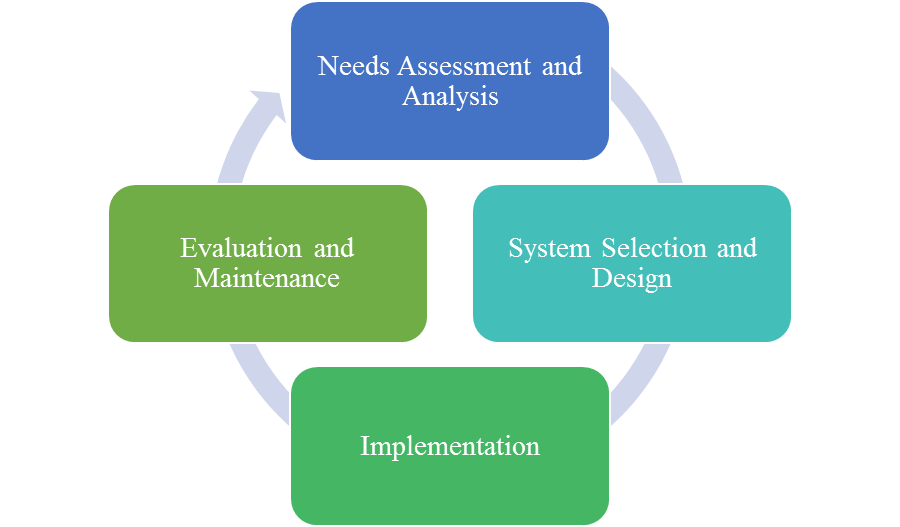
The detailed description of every phase is provided below.
Needs Assessment and Analysis
First and foremost, it is essential to carry out the relevant needs assessment and analysis. At this stage, it is necessary to identify all the tasks that are currently accomplished with the help of the existing database and determine the most critical flaws. In other words, it is required to target the needs that the new EHR system is supposed to fulfill.
Next, it is essential to carry out the technical analysis that implies ensuring that the organization has all the resources required to support the new software. After that, it is necessary to perform the economic analysis assessing the expenses required to maintain the new software. Finally, it is essential to analyze the chosen HIT system from an operational perspective. In other words, the organization needs to ensure that its personnel is properly trained to work with the EHR system.
Hence, the lifecycle of this phase might be illustrated as follows:
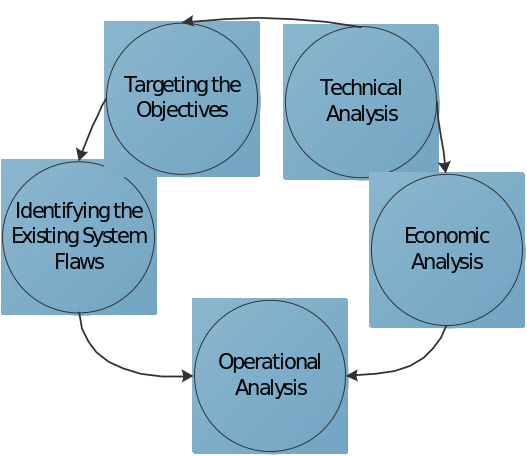
System Selection and Design
The first phase implied targeting the tasks that the EHR system will need to fulfill. These tasks should be considered in the second stage that implies active users’ involvement. In other words, it is essential to organize the meeting with the key stakeholders that ate supposed to use the software. Next, it is necessary to agree upon the system’s design that meets all the requirements stated during the meeting. After that, the project team should compose a list of all the vendors that offer the target EHR systems. The management needs to select the system basing on such factors as the product’s cost-effectiveness and the vendor’s reliability.
Thus, the lifecycle of this phase might be illustrated as follows:
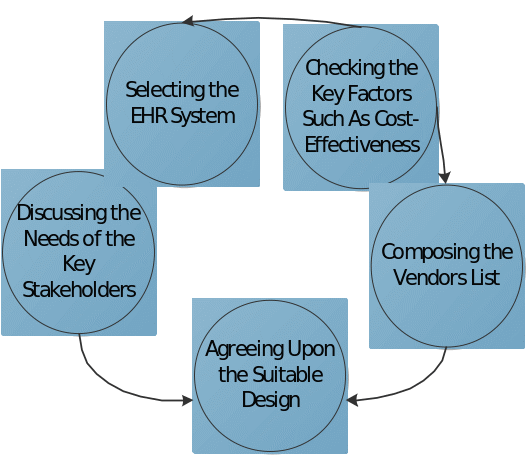
Implementation
It is recommended that the implementation of the new EHR system is carried out according to the parallel installation pattern. In other words, it is proposed that the new system is installed and runs together with the old software until its efficiency is tested thoroughly. As soon as the new EHR system is installed, the personnel should start the relevant training. Experts note that this alternative is most preferable as it allows making a smooth shift to the new technology and supplies the employees with the time essential for a comfortable adaptation (Valacich, George, & Hoffer, 2009). When the new EHR proves its efficacy and the personnel have completed the relevant training, the old equipment can be eliminated.
Therefore, the lifecycle of this phase might be illustrated as follows:
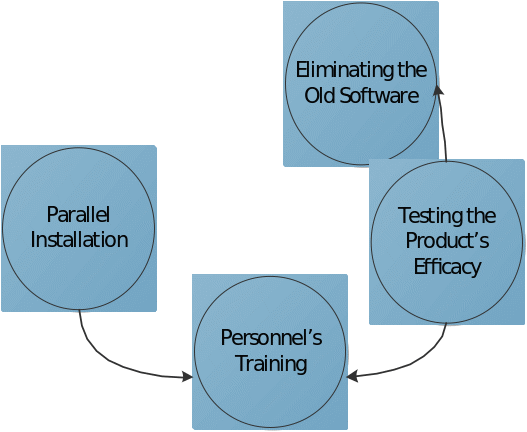
Evaluation and Maintenance
When the new EHS system has been implemented, it is essential to test its efficacy regularly. The indicated flaws should be timely eliminated to avoid potential risks of the system’s malware. To maintain the consistent operability of the installed system, it is likewise critical to ensure that it is thoroughly protected from data leaks and outside intrusion. Moreover, it is recommended to track the program’s updates and renew the system when new versions are available.
The lifecycle of this phase might be illustrated as follows:
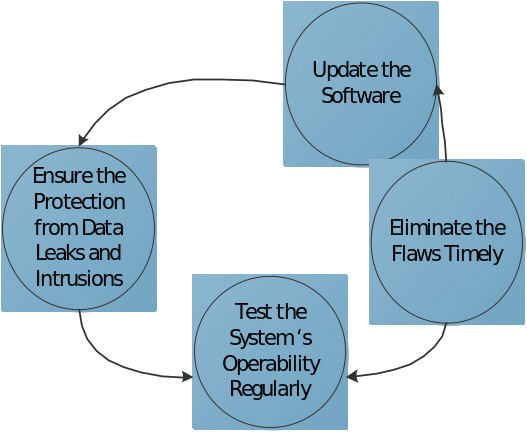
Key Elements to Be Included in a Needs Assessment and the Effects with Other Systems
In the framework of the need assessment, it is essential to understand why the old software is incapable of fulfilling the existing needs. It will help to determine the key targets such as increasing cost-effectiveness, productivity, etc. Also, it is crucial to determine the software that the new EHR product will have to run along with. It will help to target the design that will be compatible with other systems (Carter, 2012).
Key Members of the Steering Committee
The steering committee should comprise the following specialists:
- Physician Lead;
- Nurse Lead;
- IT Lead;
- HR Lead;
- Accountant.
Product Selection Strategy
It is critical to work out a consistent product selection strategy and ensure that the chosen EHR system is easy to use and compatible with other software. Therefore, it is rational to compose the list of product components that should be essentially checked.
General Components of EHR System to Be Evaluated:
- Product’s cost;
- EHR’s applications (they are supposed to be standardized);
- EHR’s compatibility with other programs (the system should not disturb the workflow);
- The system’s options (should be sufficient to fulfill the target needs) (Lorenzi, Kouroubali, Detmer, & Bloomrosen, 2009).
Potential Training Needs of the End Users
The implementation of the new technology will require the relevant training. First and foremost, it is essential to install the system – according to experts, the personnel is more likely to learn to work during real-time practice. Also, the organization might involve outside experts to monitor the training process at the early stages; however, in this case, the management should consider additional expenses. The training program must be completed before the old software is eliminated (Peck, 2013).
Conclusion
The EHR system is a convenient alternative to the paper patient records. It allows ensuring systematized work with databases and quick file sharing within different organizations. Meanwhile, the implementation of this system requires careful consideration – it is essential to see to the fact that the corporate personnel possesses the relevant skills, and the system’s design is compatible with other software so that it does not disturb the general workflow.
Reference List
Carter, J. (2012). Needs assessment: getting there from here. EHR Science. Web.
Lorenzi, N. M., Kouroubali, A., Detmer, D. E., & Bloomrosen, M. (2009). How to successfully select and implement electronic health records (EHR) in small ambulatory practice settings. BMC Medical Informatics and Decision Making, 9(1), 1-15.
Peck, A. D. (2013, July 25). EHR implementation: Training pays dividends. Medical Economics.
Thakkar, M., & Davis, D. C. (2006). Risks, Barriers, and Benefits of EHR Systems: A Comparative Study Based on Size of Hospital. Perspectives in Health Information Management, 3(5), 1-5.
Valacich, J.S., George, J.F., & Hoffer, J.A. (2009). Essentials of system analysis and design. Upper Saddle River, New Jersey: Prentice Hall.